And so, quickly, to another newsletter, written over Christmas, amidst the chaos. This one takes us into a New Year, 2025, a quarter of a century after the Millennium. Maybe there are readers who were not even born then, something I find quite incredible.
This week seems to have gone well, and I found six of the seven diary dates really quickly, as well as the cards to match them (with help from my contacts, for which many thanks). The seventh, however, as late as Friday morning, still eluded me, and I was eventually forced to pick another subject.
Anyway off we go, for the last newsletter of 2024 and also the first of 2025. May that New Year bring us happiness, but most of all peacefulness, and little pockets of calm in which we can sort (or sleeve) our cards. And may I be the first to hope that it also brings you that final card you have long been after to complete "that" awkward set.....

Anonymous - British American Tobacco [tobacco : O/S] "Types of North American Indians" (1930) 9/20 - ZB07-825 : ZB6-75 : RB/21-477
So we start this week with Iowa, which today, in 1846, became the twenty-ninth State of the Union. In fact it has been in many hands, for the area was discovered in 1682 by French explorer Rene-Robert Cavalier, who called it "La Louisiane" in honour of his King Louis XIV. Then, some time later, it was acquired by Spain, and became Spanish Louisiana, though they were extraordinarily slow to do anything with it, possibly because they realised the French would not take kindly to their rules. In the end they sold it back to France. A short while after this, the French sold it to America, in 1803, as part of the Louisiana Purchase.
At that time it was not called Iowa, it was just part of Wisconsin, but in June 1838 the area was re-organized and it became Iowa Territory - a strange shaped area which even included some of North and South Dakota and even a lump of Minnesota at the top, as well as mighty rivers, the Mississippi and the Big Sioux. By the time it was admitted to the Union it was pretty much reduced to the shape we know now, with those two rivers forming two of the borders to other states. This has, however, altered, because the rivers have occasionally changed their course due to erosion and flooding.
However, before all of this it was already inhabited, by Native Americans, and by many tribes. The first of these were the Ho-Chunk, Missouri, Otoes, and Ioway tribes.They seem not to have intermingled, or even met; the Ioway being at the top of the area, the Otoe being in the middle, just above the Missouri, and the Ho-Chunk being pretty much confined to what became modern Wisconsin. They were joined by other tribes, which seem to have been Native Americans from other parts of America, and again there is no record of whether these met or interacted. However we know that in later years Native Americans were seen by European explorers, especially the Dakota Tribes, which seem to have been fascinated by these parties, and followed them for many miles.
There are still tribes in Iowa, but their liberty is much reduced and their way of life forever altered. Three of these are descendants of the early tribes - the Winnebago, which was formerly the Ho-Chunk - the Ponca, which came in the second wave - and the Omaha, who split from the Ponca in the eighteenth century. The fourth one is more modern, they are the Sac and Fox, formerly the Meskwaki (or at least the Fox bit was), and who arrived in Iowa in the nineteenth century.
Our card shows a brave, but un-named warrior of the Iowa or Ioway Nation. I have not been able to find him in any engraving or on another card, but will keep looking. You will also find another Ioway warrior, named as Deer Ham, amidst Allen & Ginter`s "Celebrated American Indian Chiefs" (issued in 1888),
The word "Ioway" means “People of the Grey Snow" and it is a very sad story - for one summer the warriors went out from their village, perhaps in urgent need of food, and when they came back their village was different, just like it was covered in grey snow. As they neared, they realised that it was not snow, but ash, and that their homes had been set on fire.
Instead of staying put and rebuilding, they warriors moved on, frequently, perhaps fearful of another burning. In later years, with the start of the European invasions, and the many treaties, they were forced to give up their lands and move into a reservation right beside the Nemaha River in Nebraska, then they were split up randomly and some relocated to Oklahoma. Then the Europeans even stole their name, and used it, for their land.
This set is quite scarce, and not much about it seems known. And, curiously, another anonymous set, of fifty cards, titled "Indian Chiefs" was also issued by British American Tobacco, in Malta, Malaya, and South Africa, in 1930. We featured one of those as our Card of the Day for the 24th of October, 2024.
Our set is first recorded in our original British American Tobacco reference book, RB.21, issued in 1952, under section XVI - "Other English Language Issues" - a section which contains, in their words "...a residue of series which bear text in English but which do not classify for inclusion in any other sections of this volume. Many of the series were issued in the Channel Islands and Malta, or are Far Eastern issues with English text which do not fit into any of the groups in section XVII". The front index even seems sketchy about when our set was issued, using "1930-1940" - a very long time frame indeed. Anyway in section XVI it is described as ;
477. TYPES OF NORTH AMERICAN INDIANS. Small cards, size 68 x 57 m/m. Front in colour. Back in grey, with descriptive text. Numbered series of 20. Anonymous issue. with letterpress on back.
Because it is anonymous, it is sent to the back of our original World Tobacco Issues Index and recorded, amidst the "Z" codes. Some of the sets in this section do say where they were issued, but ours does not. The description reads :
TYPES OF NORTH AMERICAN INDIANS. Sm. Nd. (20). See RB.21/477 ... ZB6-75
And this text is identical in our updated version, only the code having changed, to ZB07-825
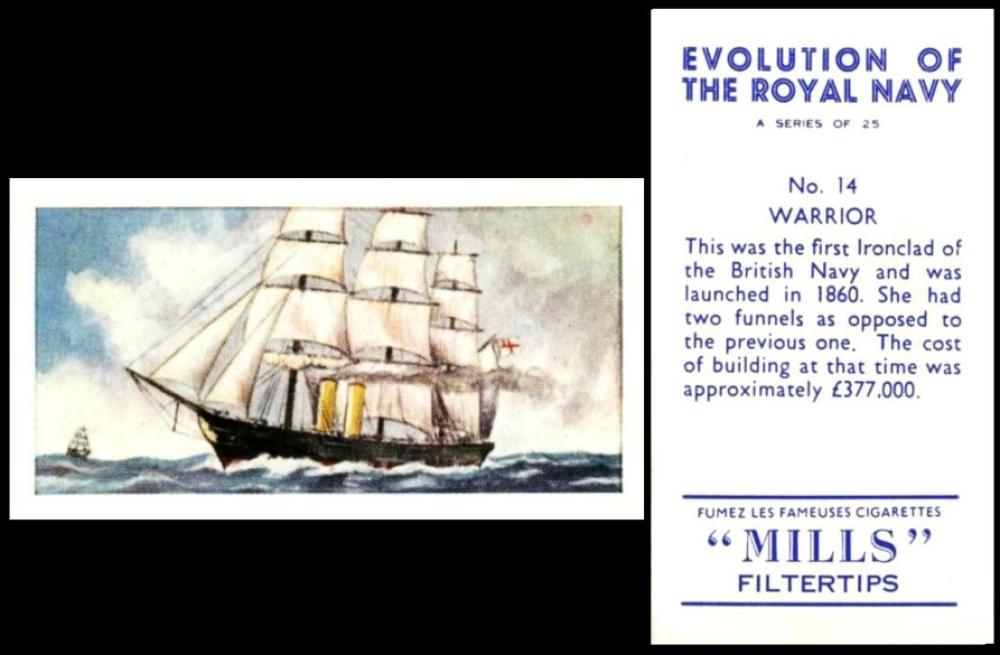
Amalgamated Tobacco [tobacco : UK] "Evolution of the Royal Navy" (1957) 14/25 - A495-320
It was less than twenty years after Iowa became a State that this amazing vessel was launched. She was totally clad in iron armour, and she took three years to build, being launched, as they say on this card, in 1860. Less well known is that she also had a sister, "HMS Black Prince" about who less is written, and who appears on many less cards.
The first thing we must do is bust a myth - for these ships were not the first iron-clad warships; that honour goes to the French "Gloire", launched in 1859, the same year that our ships were hurriedly commissioned.
Strangely HMS Warrior never was a true warrior and never fired a gun in anger nor repelled a single boarder. She started off sailing around our coastline to show how superior she was, and then ended up patrolling with the Channel Fleet. Then, in 1873, she was superseded by HMS Devastation, and was downgraded to simply a reserve ship, before she was decommissioned ten years later. Now at this point many great ships were simply scrapped, but for some reason she was used as a depot for stores and to accommodate men who were waiting to go to other ships.
Just after the turn of the twentieth century she was given over to the torpedo training school, perhaps even as a target, but they had great affection for her and let her be, only converting her in 1927 as an oil storage boat. They must have treated her kindly, even in this lowly role, for fifty years (during which time this card was issued) - for she was still more or less intact.
Then she was given over to the Maritime Trust, who lovingly restored her over the next ten years and moored her as a museum, in the shelter of Portsmouth Harbour, where she can be visited to this day as part of the Historic Dockyard complex.
As for her sister, who also never fought a single battle, she found herself in the Channel Fleet, then was sent off to Ireland in 1896 and used as a training ship. She then moved to perform a similar role in Portsmouth, but she was broken up, and sold for scrap, in 1923.
This set is entirely absent from our original World Tobacco Issues Index, for it was issued shortly after that work went to press. In fact the only two British issues in that book, listed under a heading of "Section 2 - Issues 1953-54" are "Kings of England" and "Propelled Weapons".
These remain the only issues in that section in our updated World Tobacco Issues Index, but a new section has been inserted in third place, which covers "Issues 1957 onwards". However this section also reflects that all these cards were issued in Mauritius, though it is split between cards in the English language and cards in French. Sadly the descriptions are very basic, and our set simply reads :
EVOLUTION OF THE ROYAL NAVY. Sm. Nd. (25) ... A495-320
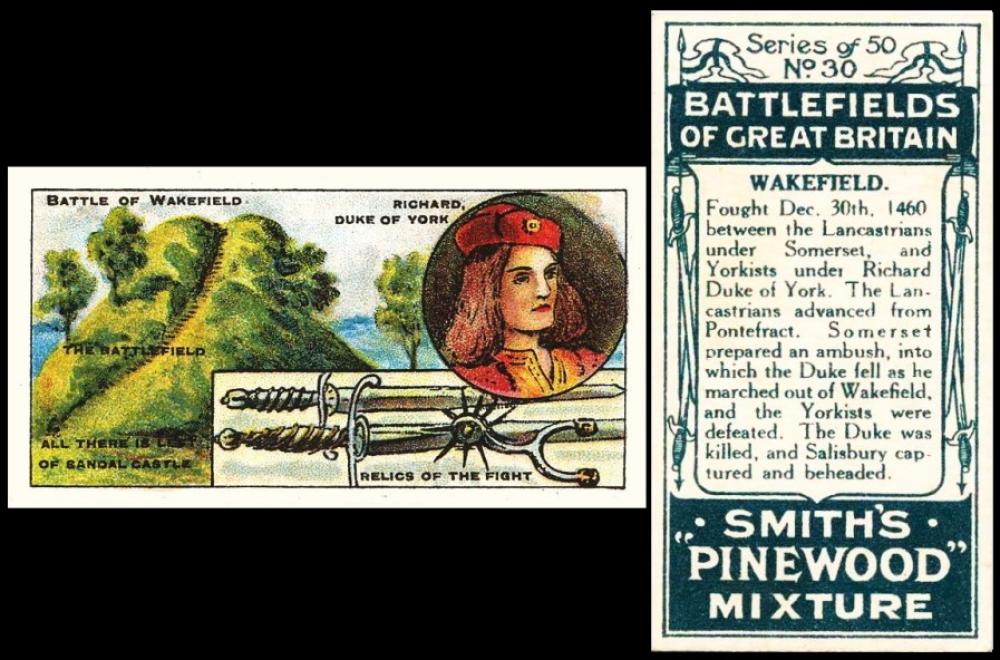
F. & J. Smith [tobacco : UK] "Battlefields of Great Britain" - `Pinewood Mixture` brand (December 1913) 30/50 – S548-050.K : S84-2.K
This is the eighth back we have now featured from this multi-branded set. If you want to see the rest, then click along to its home page, which is the Card of the Day for the 20th of March 2024
To our diary date, today marks the date of this fateful battle, in 1460, when Richard, Duke of York, shown in the circle inset on this card, was defeated. In fact, as the card tells us, it was a bit more than that, for "The Duke was killed and [Richard Neville, 5th Earl of] Salisbury captured and beheaded." Actually both men were beheaded, along with Edmund, Duke of Rutland, and their heads were stuck on poles above Micklegate Bar in York. This rather grisly fact is partially mentioned on Nicolas Sarony`s "Links With The Past", card 7/25 - partially, because it only mentions one head, that of Richard, Duke of York.
A brief biography reveals that Richard of York was born in September 1411 to parents directly descended from Edward III. In fact his father was the first ever Duke of York. Then, in 1425, all manner of deaths and confusions led our Richard to believe, and rightly so, that his lineage ought to have put him on the throne of England rather than Henry IV. And so was fought the Wars of the Roses, Henry, a Lancastrian, choosing as his emblem a red rose, whilst Richard of York chose a white one.
This battle, Wakefield, was near Sandal in West Yorkshire, site of the former Sandal Castle (which is mentioned on the front of the card, but is rather hard to read). This was where Richard III intended to make his home, but all building halted when he was defeated at Bosworth, which is almost certainly why it fell into ruin - though there is more of the castle remaining than this picture leads you to believe. In fact our Richard, Duke of York, had also been living there. with many of his soldiers - and it was from there that he rode out on the fateful morning of this battle, straight ahead, towards where the Lancastrians were sited, to the North of the castle. However, as he did this the Lancastrian forces mustered behind him and as he went into battle they attacked from the rear and sides. This prevented him making any attempt at retreating to his castle, and within half an hour he and many of his men were dead.
Whilst Richard was never destined to be king, his son, Edward, took up the claim to the throne at the age of eighteen as soon as heard of the death of his father, and marched out to war. He was more successful, and trounced the Lancastrian forces at both Mortimer`s Cross, in February 1461, and Trowton, in March of the same year, he then managed to capture Henry VI in 1465 and imprison him in the Tower of London. There was a very brief restoration, which Henry seems not to have wanted, for he was quite weak by then - this ended very badly, with the death of his son in 1471, followed by his own death, (or maybe murder), upon which Edward took the throne, as Edward IV
Today`s card advertises "Pinewood Mixture", but there is also another "Pinewood" back associated with this set, namely "Smith`s Pinewood Cigarettes". The reason for this is that the "Mixture" would have been tobacco, for the pipe, and presumably the cards would have been inside a tin rather than a cigarette packet.
.
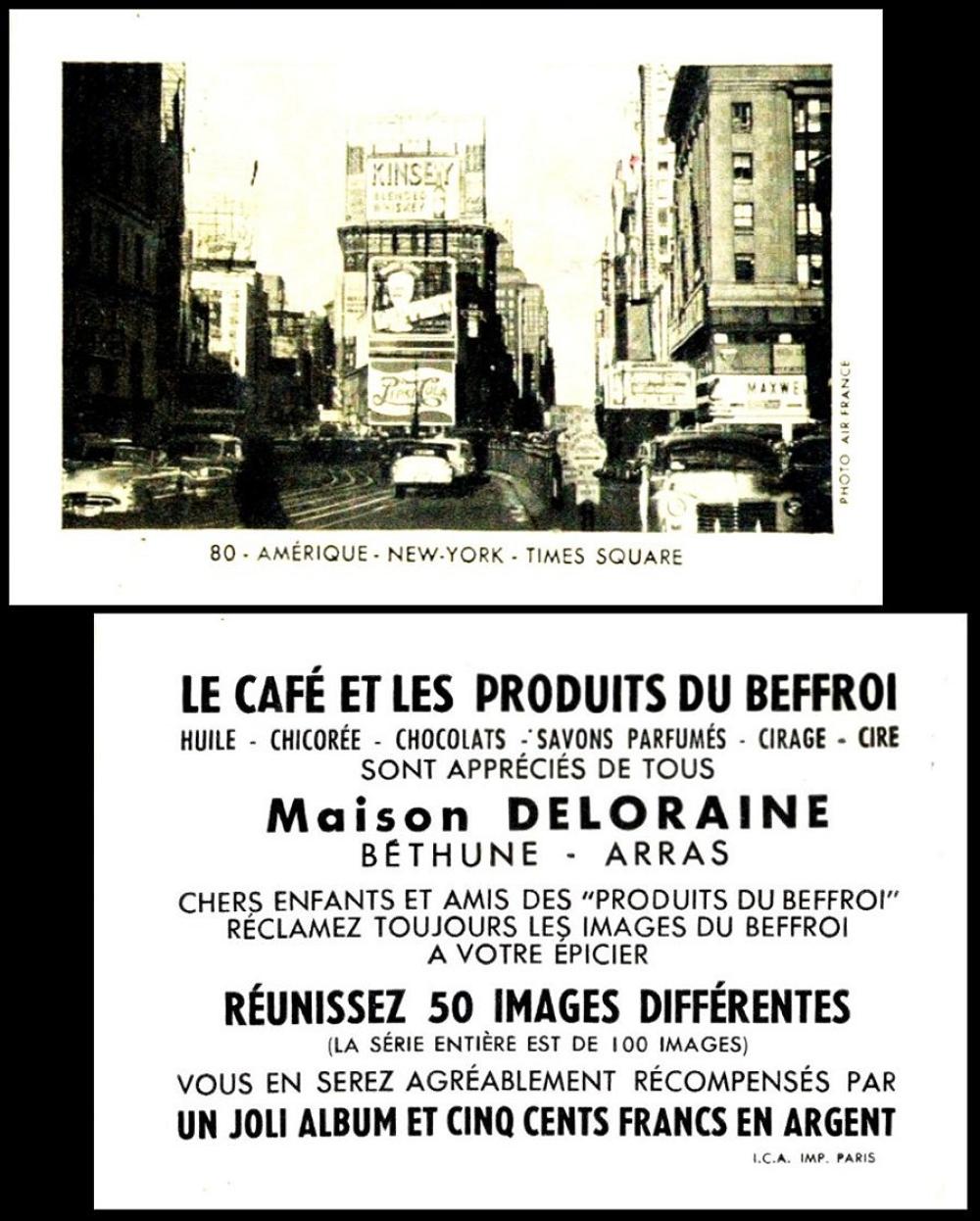
Maison DeLoraine [trade : coffee : O/S - Bethune and Arras, France] "World Views" (19) 80/100
Today is the end, and the beginning of 2025, for it is New Year`s Eve, and there are many revellers who, it can be rightly said, do not actually know (or care) when one ends and the other begins.
As far as celebrating the New Year, this has always happened, starting, we believe, right back in Mesopotamia, around two thousand years before Jesus Christ was ever thought of. However, it was not today, for their New Year came in March, with the Spring Equinox, which they considered marked the change between one year and the next. And even on the Roman calendar it declared that the New Year began on the first of March. It was not until 1582 that Pope Gregory XIII decided to revise the calendar and make January the first his New Year`s Day
Now in the modern era, the place to see in the New Year seems to have been Times Square in New York. This happened a while ago, and was first held in 1904, as a one time celebration party, with fireworks, simply to mark the "New York Times" newspaper moving into their new building in Longacre Square. The owner of this newspaper, Adolph Ochs, had begun his career at the lowest level of the printing industry and worked up, by hard graft, eventually buying the New York Times in 1896, though he had to borrow most of the money to do so. Despite that, in 1904, he was able to reduce the cover price to just one cent, a third of its former cost, and the circulation immediately increased - in fact such was the renown of this paper that Longacre Square became Times Square, by order of the City of New York.
This 1904 celebration was such a success that it was held again in 1905 and 1906. Then, on December 31st, 1907, he set up an illuminated ball, which dropped down a pole on the striking of the New Year. A few years later, in 1913, the newspaper moved its headquarters to Forty-third Street, though they continued to own the Times Square building, and the New Year events are still held at the same site.
They have only failed to take place twice since, both times being due to wartime black out rulings, in 1942 and 1943. In case you are wondering about these dates, thinking the Second World War started in 1939, the Americans only joined in that war after the bombing of Pearl Harbour in 1941. And as for the lighting restrictions, which began in January 1942, they were, much as ours, to prevent lights being used for invasion or for location sighting in bombing - and some American states also had air raid drills. And whilst there was never an invasion of American soil by foreign troops, there were several German spy rings whose plans would have included bombings if they had not been caught - and the Japanese forces launched several bombs from submarines, as well as floating incendiary balloons across the Pacific Ocean, many of which did make the five thousand mile crossing and one of which killed six civilians.
Now this scan was sent to me as a set entitled America, but I have done a bit of research and it appears to cover the entire world. Curiously it was some kind of co-promotion by Air France, whose name appears up the right hand side, and presumably supplied the photographs. They were founded in February 1919, not as Air France,but as Societe Generale des Transports Aeriens; Air France only came along in August 1933, after a merger of that company and four others. Nationalisation, which came along in 1945, saw Air France being given the reins of all the other aviation companies, and this led to another name change, coincidentally on the 1st of January 1946.
It seems that Maison DeLoraine was a specialty, or "house" coffee, and this is what these cards were issued with. However the list of goods on the back of the card suggest that the actual issuer was a grocer, for they are "oil, chocolates, soaps and perfumes, chicory [or chicory coffee] shoe polish, [and] fabrics.". Some say that "Beffroi" is the company name, but I think that may be a trade mark, referring to the belfries at both Bethune and Arras. However, if anyone knows who did issue these then please let us know.
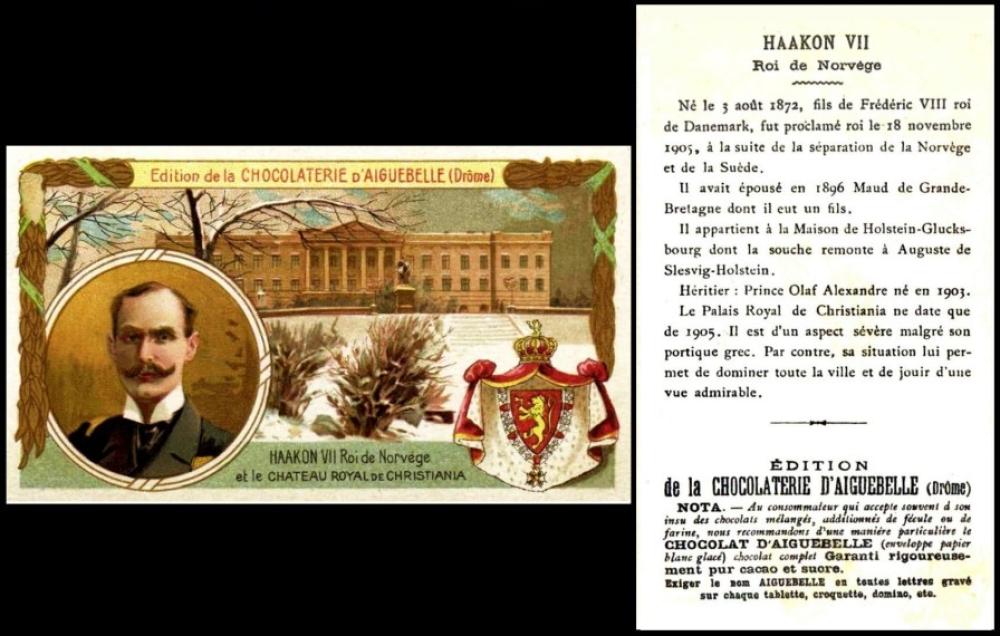
de la Chocolaterie D`AIGUEBELLE [trade ; chocolate : O/S - France] "European Royalty & Palaces" (1912) Un/12 -
Today, in our first centenary of 1925, we celebrate the renaming of Christiana to Oslo. And we actually have a card showing King Haakon VII, the ruler of Norway, and his palace, the Chateau Royal at Christiana.
Oslo has a bit of a tale to tell, name wise; it started in 1040 as Aslo, which many historians wrongly wrote down as the mouth of the Lo River, then supported by saying the Lo had long since disappeared. Today we are certain that there never was a River Lo, only a meadow, which is what "lo" means in German, almost certainly because it was flat ground that often flooded in wet weather.
It stayed as Aslo right until 1624, when the town, or at least the old Medieval part, was was burned almost to the ground. This gave an opportunity to draw it closer to Akershus Castle. It looks like the newly built section was then renamed Christiania in honour of the current Danish and Norwegian King, Christian IV, whilst the old part to the east was called Opslo. The King died in 1648, but the town remained named after him right until 1877, when it was officially changed to Kristiania - though it seems the residents, and the municipality itself were reluctant to follow suit, and this name only appears in official documents right until 1897, when it did start to be used, albeit grudgingly, by the inhabitants.
Then, in July 1924, it was announced that the entire city, east and west, was to be renamed Oslo. This was also unpopular, mostly from the people who lived in the Christiania segment. However their pleas and entreaties fell on deaf ears and today, in 1925, Oslo was born.
As far as the cards in this set, they are :
- Belgium - Albert I - Brussels
- Denmark - Frederic VIII - Fredriksborg
- Germany - Kaiser Wilhelm II - Berlin
- Greece - George I - Athens
- Great Britain - King George V - Windsor
- Italy - Victor Emmanuel III - Rome
- Norway - Haakon VII - Christiana
- Rumania - Charles I - Bucharest
- Russia - Nicolas II - Peterhof
- Serbia - Pierre I - Belgrade
- Spain - Alphonse XIII - Madrid
- Sweden - King Gustav V - Stockholm
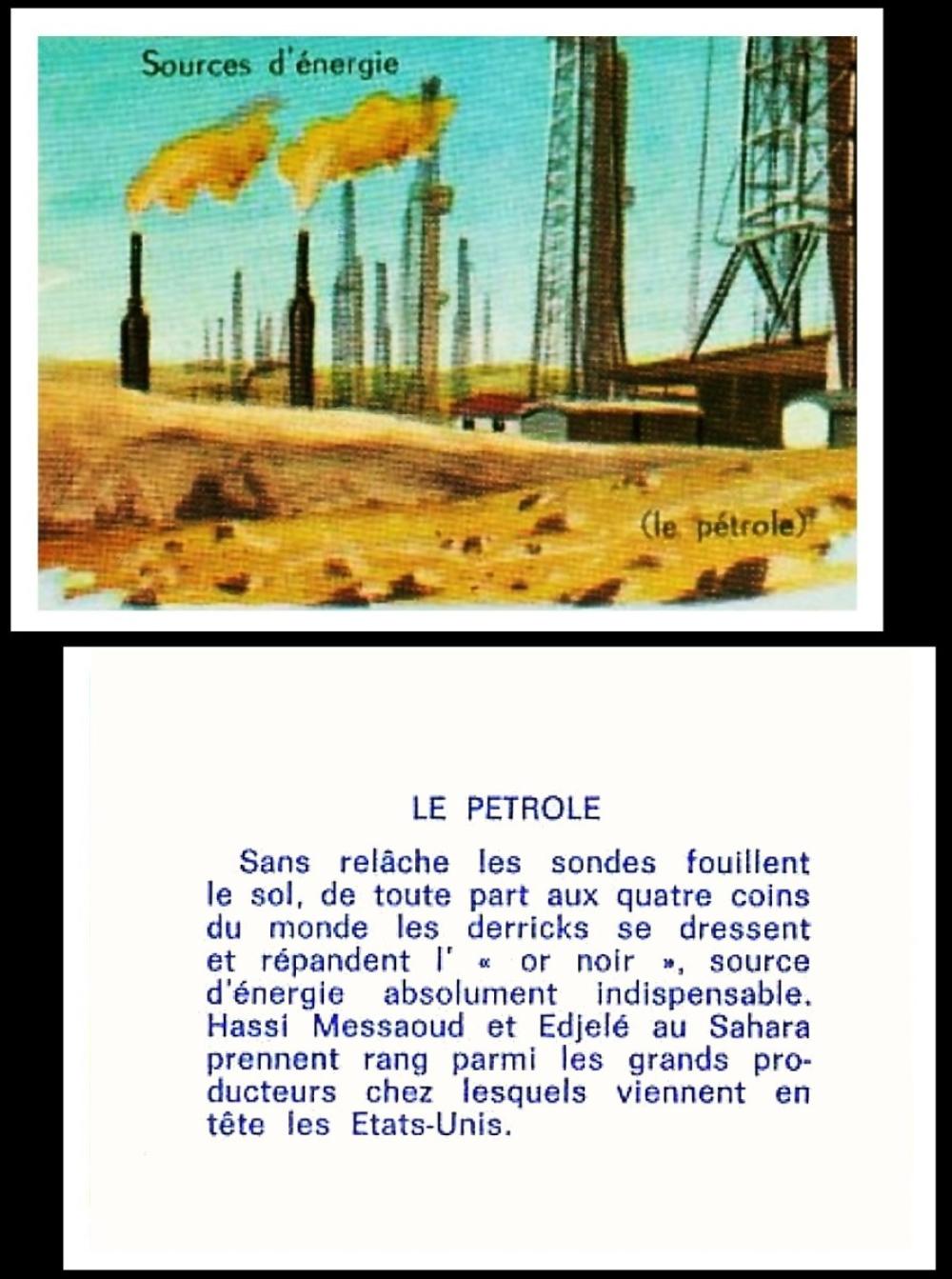
So this is the day that caused all the trouble. First off it started out as something that I figured gave me lots of scope for Cards of the Day as next week`s theme, so I changed it, to the 1941 destruction of Cardiff Castle in the Blitz. However I could not find a single card of Cardiff Castle. Then I discovered something else - except it was not, that event actually being on the fourth of January (but at least I have one day already completed in the next newsletter).
Anyway, after frantic searching, whilst I was making my tea, I have come up with the fact that it is "55 mph Speed Limit Day". As for the why, though, well that is a very convoluted tale, with three equally valid schools of thought.
The first one, which is the view held by a lot of drivers, including many driving experts, says that this day celebrates the truth that the lowest speed you should hold for any length of time is 55 mph and the highest 65 mph. Driving slower, or faster, than this means that you are wasting fuel unnecessarily, which is also why fuel economy is much worse in towns than on the open roads. And they swear this is why the day was invented, as a gentle reminder for anyone who may have started driving in the twelve months prior.
The second one reminds us that on this day in 1974, President Nixon signed the Emergency Highway Energy Conservation Act, which, for the first time, set the maximum speed limit in every State across America, at 55 mph. Before this it was up to the States themselves to set their limit, based on the terrain of that locality. And this maximum speed limit applied to all drivers, whether they be full term residents, or holiday makers; they had to keep to it or else. And it was not repealed until 1995.
However, though to the general public, this seems to have been drafted on safety, and on fuel economy grounds, there is quite a lot of hidden information, and even paranoia, which actually made the 55 mph speed limit come about. And that was the fact that in the 1950s, 1960s, and early 1970s, there was plentiful, and cheap. access to oil (and hence petrol), direct from the Middle East. Then, in 1973, Arab members of OPEC (the Organisation for Petroleum Exporting Countries, founded in 1960) suddenly hit the protest button. This all came out of the conflict between the Arabs and the Israelis, and especially because the West had come out pretty strongly in support of Israel. Therefore the Arabs decided to nit back by restricting supply of their oil to those Western countries, chief amongst which was America, but which also affected Europe and Japan - and not just restricting it, but quadrupling the price.
President Nixon was faced with a dilemma. He could either admit that America was being squeezed by another country, or he could fudge it a little and appeal to a greater need for safety. He needed that oil, not so much for domestic cars, however much the American public thought they had to have them, but for industry, and also for military usage. It was indeed true that lower speed limits would save fuel, and maybe, in a few months, the situation would blow over. In fact it took until 1974 for the embargo to be lifted on America, before which rationing cards had been hurriedly printed and circulated. Documents, newly released, also prove that America planned to invade, and take over oil fields across the Middle East. This never happened, but the way these documents are drawn up suggests that was only because the Arabs relented first.
Now this card is very thin, and is anonymous. However, there is a slightly thicker series of cards, with the same image, and text, but with a frameline to the reverse, and that seems to often cited as having been issued by Volumetrix, of Lyon and Paris, in the 1960s. I have now been told that Volumetrix published a large series of albums, for educational use, into which the stickers, (which seem to have come on a sheet, divided by dotted lines for cutting) were stuck. There was an amazing range of subjects, and the albums turn up quite easily, and are not too expensive. However I have not so far found the album into which this sticker went.
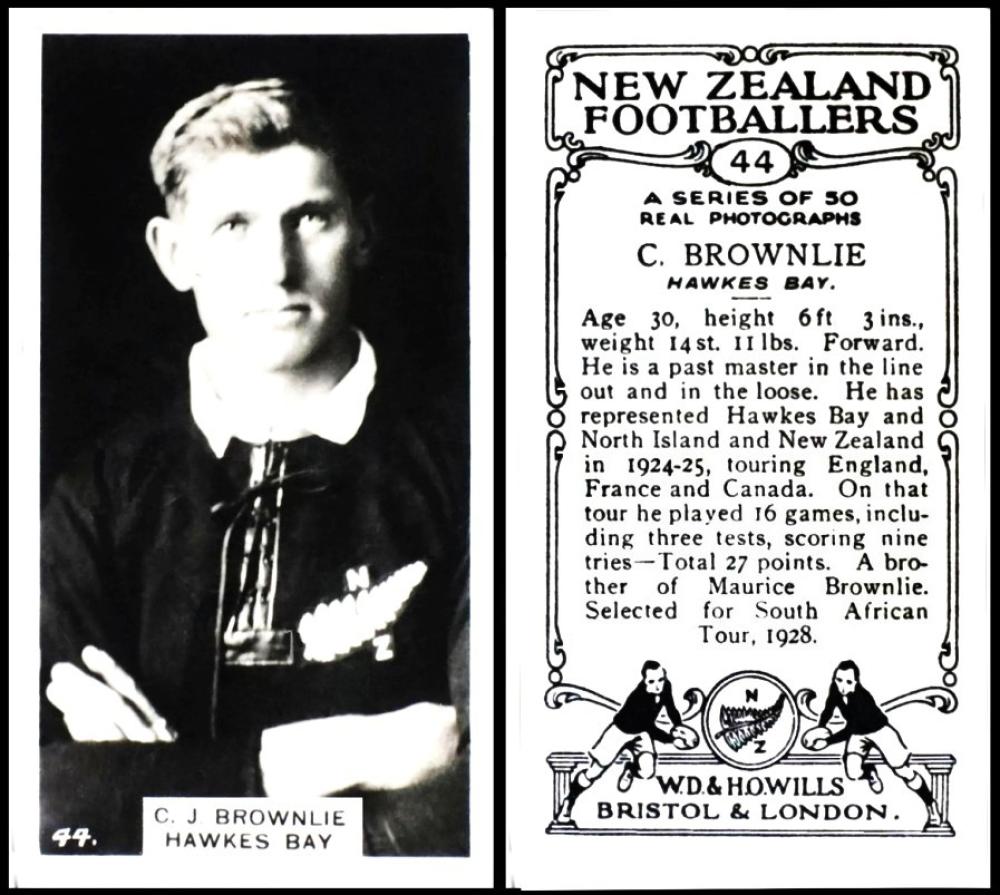
W.D. & H.O. Wills [tobacco : UK - Bristol] "New Zealand Footballers" (1928) 44/50 - W675-662 : W62-460 : W/275
This card also caused no end of trouble, but then I miraculously found out that today, in 1925, and therefore giving us another centenary, the first ever sending off in a Rugby Union Test Match took place.
It is sometimes recorded that our man was the first player ever to be sent off - but that is incorrect, for that dubious honour goes to the Welshman Willie Thomas, quite some years earlier, in March 1881, in a game between Wales and Scotland in Edinburgh. There seems to have been some sort of bad feeling right from the start at that match, and maybe even before, and within ten minutes both teams had just abandoned play and set to brawling, with the game being eventually halted after just fifteen minutes on the field. Why Willie Thomas was singled out, who knows, it must have been hard to pick one offence out of that furious melee, unless he was seen to throw the first punch, of course.
The sending off of Cyril James Brownlie took place at Twickenham, during a match between two of what were known as International Rugby Board Countries - namely New Zealand and England, and what happened, just ten minutes into play, was that the All Black Brownlie was sent off the field. His offence was to kick an English player, on the leg, whilst said player was already laying face down on the ground. This does seem a rather minor offence, and it must be said that it seems that the sending off was more connected with the fact that it took place before the Prince of Wales, and the Prime Minister, Stanley Baldwin. If it had been an English player, we can but wonder if the same would have been the punishment. And there are records that the Prince of Wales attempted to intervene, without success.
Anyway, I did find that a complete account of this send-off saga appears online at Keith Quinn Rugby, and it is really fascinating.
Returning to our man, Cyril Brownlie, he was born on the 6th of August, 1895, in Whanganui, and he was the oldest of three brothers (the others being Laurie and Maurice) all of whom played as forwards, for the All Blacks, in the 1920s. Strangely though, although he was the oldest, he was the last to be selected to play for his country being spotted in 1922 at a match involving his team, Hawke`s Bay.
This incident did not remove him from the All Blacks and he continued to play for them in 1926 and 1928, some thirty-odd occasions. But for some reason he retired from the game in 1930. And what he did after that seems not to have been recorded, though we do know that he had a farm at Hawke`s Bay.
He died at Wairoa in May 1954.
Our set may be called "Footballers" but every card shows a member of the All Blacks Rugby Union squad, though the bottom title, inset into each photo, gives the name of their home team, hence our card says "Hawkes Bay". Most of the players, if you look at the picture, are also sporting their All Blacks jumper, with its emblem of the silver fern. And in addition the two players drawn on the bottom of each card are definitely playing rugby rather than soccer. This seems to suggest that the set was added to our records without ever seeing a picture - and that is supported by its first appearance in any of our reference books, which was our original Wills part IV, issued in 1950, for that reads :
275. NEW ZEALAND FOOTBALLERS. Fronts : Glossy photo-prints in black and white. Backs in black, with descriptive text. New Zealand issue, 1928.
Now we know this set was not printed in England, and shipped out for issue, it was printed on site in New Zealand - and so it is absent from the lists of issuing dates that was printed in our hardback book which reprinted all the original Wills books into one volume.
Even better, research has found some of the images, including ours, as proper photographs, which were taken by Crown Studio Ltd. of Wellington, North Island, New Zealand. I suggested that it was possible that they took more images that ended up being used for this set as well - and I have now found the photograph used for card 16, of Alan Charles Robilliard. When I get time I will have a better hunt and see if I can find all fifty - unless anyone else would like to do that, at the National Library of New Zealand website.
In our original World Tobacco Issues Index it was a bit harder to track this set down, but I found it under section 5.B of the Wills listings, "Other Export Issues ... issued through B.A.T". The heading for this section tells us that it was "Issued chiefly in New Zealand, some series in Malaya, Malta, and elsewhere." It is listed as :
NEW ZEALAND FOOTBALLERS. Sm. Black and white photos. Nd. (50) ... W62-460.
There is still not a word that these players are not footballers, six years on from their original appearance in part IV of the Wills reference books. This even remains the case in our updated version of the World Tobacco Issues Index, issued in the year 2000 - in which the listing is exactly the same as the above, save the new code of W675-662
This week's Cards of the Day...
have been discovering Johannes Kepler, who was born on the 27th of December 1571. Now though today he is known for his scientific work in the fields of astronomy, astrology, and mathematics, he was also a philosopher, a musician, and also an author, with a very important claim to fame. And because of him, many scientists through the years were inspired to make their own discoveries.
Saturday, 21st December 2024
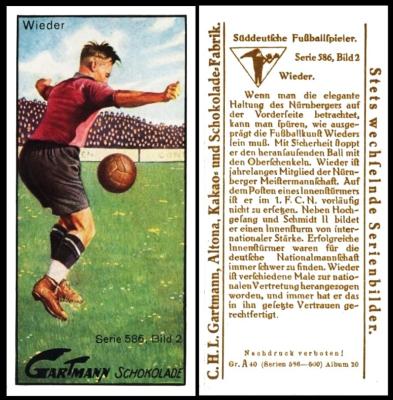
This card was chosen because it shows a German player and was also issued in Germany. Johannes Kepler, on a modern map, was also born in Germany, in a place called Weil der Stadt, which is about nineteen miles west of Stuttgart. However, when Johannes Kepler was born, it was actually the Free City of Weil der Stadt, and was part of the Holy Roman Empire. Less than twenty years after his death it was entirely destroyed, during the Thirty Years War, though it was subsequently rebuilt. And, rather aptly, it also has a second name - of Keplertown.
Our man of the moment is Ludwig Wieder, and there is little about him online, though we do know that he was born in March 1900, in Nuremberg, and that he lived until December 1977. Even Wikipedia only has him down as "a German International Footballer", though they do have dates, showing that he joined F.C. Nurnberg in 1922, and was on the German International squad a year later, eventually playing in six games and scoring two goals. He stayed with Nurnberg, which was his home town team, until 1931, then it appears that his non-football job, he was an engineer, took him Duisburg, some three hundred miles from home. He did continue to play football, with a new local team, Postsportverein Duisburg, and he also became the club trainer. This led him to being headhunted as a coach by Alemania Aachen, where he was from 1937 until the outbreak of the Second World War. Once that was over he found himself in East Germany, where he became a sports coach and trainer, seemingly with schools, or youngsters anyway.
These cards may come from Germany, but Gartmann was originally a Swiss company, dating from the late eighteenth century. Remarkably it is still in family ownership.
Their football sets started in 1924, with Series 571, "Augenblicksbilder vom Fussball" (or "Moments in Football"), a title which would be repeated for nine other sets. In between those were other, non related sets, and also more football sets, regional ones. Some collectors believe that the general "moments" sets were issued across Germany, whilst the regional ones were only issued in that particular area - something which is backed up by the dating, 1924 having three general sets and a set each from North and South Germany, 1925 having five general sets and one each from Berlin and Central Germany, 1926 having a general set and a second North German one, plus one entirely devoted to a single game, Hamburger SV versus Cambridge University, which Hamburger SV seems to have won 6-1.
Sunday, 22nd December 2024
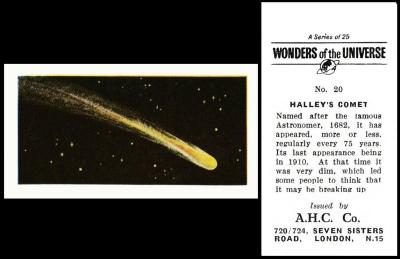
This card represents the most incredible event of the young Johannes Kepler`s life, for in 1577, at the age of six, his mother dragged him away from his schoolwork and up to the top of a hill, where he watched a comet streak, quite visibly, across the darkened sky. His mother must have also had some learning, for she told him all about the comet and hence was introduced to astronomy.
He was also shown a Lunar eclipse at the age of nine, and he spoke of this often thereafter, especially how the moon changed colour.
The main reason for using this card, though, is that the mighty comet that Johannes Kepler saw in 1607 was the same one seen by Edmond Halley in 1705. In fact, Edmond Halley used Johannes Kepler`s records to find and identify it. It turned out that it was the exact same comet which had also been seen from Earth in 1531 and 1682, almost every seventy-five years. And Edmond Halley also declared that it would return in 1758, which it did, but he had died before he was able to see if for himself and realise that he was correct. There is something else too - for Johannes Kepler's third law of planetary motion can be used to calculate the axis of Halley's Comet.
I do not know why we call it Halley`s Comet, though, and not Kepler`s.
As far as this set, it first appears in our British Trade Index part two, as :
A.H.C., London, N.15
Ace High Confectionery. Cards issued 1955-56. See ANONYMOUS set ZB9-55WONDERS OF THE UNIVERSE. Sm. 69 x 38. Nd. (25). See D442 ... ACC-1
The "D" code always means that the set was duplicated, or issued by another company, and they are listed at the back of the book. In this case the other companies were Edwards & Sons of London S.E.19. who issued them in 1954 with "Lucky Dip" sweet cigarettes, in two versions, with and without the series title - and Foto Bubble Gum, which was actually a brand, owned by Beano Ltd of Woodfield Road, London, W.9; they issued this set in 1957, but in a different size, of 70 x 38 m/m
By the way, the anonymous set is "Tropical Birds. Sm. 67 x 36. Nd. (25). See D.414-1. Issued by A.H.C." - and the D.414 tells us that it was issued by lots of other companies, this one being a set of twenty five, taken to be the first series, and also issued by Sweetule in with "Junior Service" sweet cigarettes in 1955 - whilst the second series was issued by Amalgamated Tobacco (a proper cigarette card, issued in 1959), Browne Bros. of Southend on Sea (with tea, in 1966), H.E. Empson & Son of Birmingham (with tea, in 1966), Musgrave Brothers Ltd of Cork (with tea, in 1964), Northern Co-Operative Society Ltd of Aberdeen (with tea, in 1966), Sketchley Cleaners (in 1959) and Wilcocks and Wilcocks Ltd of Exeter (with tea, in 1965).
Now in our updated British Trade Index these two sets by A.H.C. are put back together, and so the listing there reads :
A.H.C., London, N.15
Ace High Confectionery. Cards issued 1955-56.TROPICAL BIRDS. Sm. 67 x 36. Nd. (25). Letterpress back. Anonymous. See HX-13 ... AAH-040
WONDERS OF THE UNIVERSE. Sm. 69 x 38. Nd. (25). See HX-14 ... AAH-080
Monday, 23rd December 2024
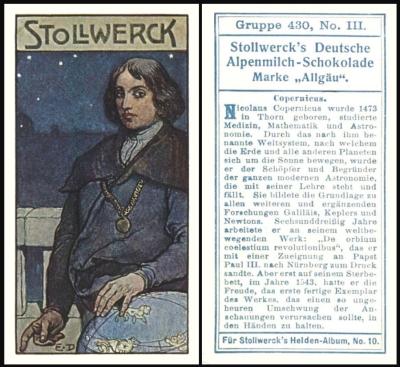
Now when Johannes Kepler went to to the University of Tubingen in 1589, he discovered the theories of this man, Nicolaus Copernicus, and it is reasonable to say that they changed his way of thinking forever. Copernicus was a follower of a radical, and in many fields, banned thought, that the sun was the centre of the Universe, and everything revolved around it, according to its will. However many people at the time followed the opposite idea, that the Earth was the centre, and controlled the Universe.
Whilst he was at the University, Johannes Kepler studied philosophy and theology, but he was also interested in mathematics and the often seen as unconnected arts of astronomy and astrology - though the truth is that they are very much connected. However it was only in the following year that the new Chancellor of the University gave him the chance to study the works of both the Egyptian Claudius Ptolemy and his Polish follower Nicolaus Copernicus, the former being more normal, and the latter being considered against current beliefs. Johannes Kepler was fascinated by the differences between the two, and became a great follower of the radical suggestion that the sun was the centre of the solar system and drove the other planets about it through force of will.
This would come back against him not long after, when he was denied his desire to become a Lutheran minister, that faith believing, and quite immovably, that all the planets, and the sun, moved around the Earth. However, because of this, he did not abandon his studies and join the church, he became a teacher, of mathematics and astronomy, at a Protestant School in Graz, Austria.
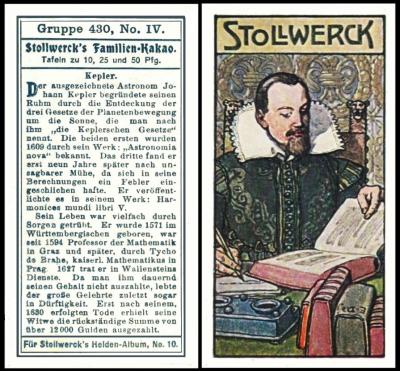
Though our main card shows Nicolaus Copernicus, there is also a card of Johannes Kepler in the set, and it is immediately after this one.
It is also considered to be his "Rookie" card, but there is another, issued five years before, which we will read about tomorrow.
If you look closely at it you will see that the second section of this reverse advertises "Stollwerck`s Familien-Kakao, Tafeln zu 10, 25 and 50 pfg."
This is a different product from that which appears on our main card, and, in fact, almost all the cards have different products, these being :
1. Stollwerck`s Extra Zart
2.
3. Stollwerck`s Deutsche Alpenmilch-Shokolade Marke "Allgau"
4. Stollwerck`s Familien-Kakao, Tafeln zu 10, 25 and 50 pfg.
5. Stollwercks Frauenkron-Shokolade
6. Gebr.Stollwerck A.G. Stammhaus Coln am Rhine
Card 2, of Gutenberg, is the odd man out, for he only has the small top box saying "Gruppe 430, No. II". There is no larger second box beneath with an advert, it just goes into the large box with all the text. I have no idea why this is.
Tuesday, 24th December 2024
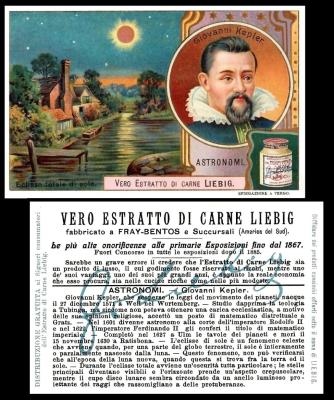
This is the true "Rookie" card for Johannes Kepler, and it is part of a very impressive set, with amazing colours, which remain fresh and bright, though it was issued almost a hundred and twenty years ago.
It was circulated in Belgium, France, Germany, Italy and the Netherlands. Most of these call it variations of "Astronomes" (Germany uses "Astronomen", and Italy, which is the version we show here, is "Astronomi") - but in the Netherlands it was called "Sterrenkundigen". However, all translate to Astronomers.
As for scarcity, they are all fairly easily available, but you may have to pay a bit more for the Netherlands version.
The astronomers included are :
- Francois Arago
- Nicolaus Copernicus
- William Herschel
- Johannes Kepler
- Isaac Newton
- Giovanni Schiaparelli
Wednesday, 25th December 2024
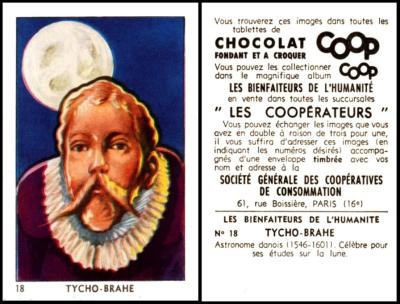
So we left off our story with Johannes Kepler going off to Graz in Austria to teach mathematics. He started there in 1594, and almost immediately began to plunge into his studies of astrology, especially his belief that it was a valid way to connect the human with the sky above, and also to make astronomy more accessible to everyone. He took some time off to get married, to a young widow with a young daughter. Her parents opposed the match, but in the end it worked out, and they were wed in 1595. Sadly both their first two children died whilst they were very small; but later on they had three more who survived, for a while at least.
In 1596 he was far along enough in his theory to publish a book, the Mysterium Cosmographicum. He had also started the research into four further books, on the sun and its stars, the planets and their orbits, their relative geographies, and a follow up covering meteorology and gravity. To write these he asked for assistance, especially with his research. One of the scientists he wrote to did not reply directly, but he did publish the letter, purely to get back at his own old rival, the Danish astronomer, Tycho Brahe. This did not particularly seem to bother Tycho Brahe, and in fact it inspired him to contact Johannes Kepler directly, which led to many discussions on all manner of scientific subjects, and to a kind of friendship even. Indeed it was Tycho Brahe who taught Johannes Kepler to never rely on what was written down in other people`s research, but always to question and to double check it.
They even met up, in Prague, in 1600, and stayed for several months, during which Johannes Kepler was able to see Tycho Brahe`s new, purpose built, observatory. However, towards the end of their stay, Johannes Kepler wanted more access to its features, and, rather foolishly, he tried to involve a third party, which led to a major falling out and a forced departure. However things cooled and contact was again made, which led to Tycho Brahe`s making a formal offer of employment, and also allowing the entire Kepler family to move there, something which came at just the right time, because in August 1600 Johannes Kepler was forcibly ejected from Graz for his refusal to convert to the Catholic faith.
Tycho Brahe died in October 1601, at the age of fifty-four, and Johannes Kepler was appointed to take over as the Imperial Astronomer. This also meant that he could stay in Prague, which he did, for the next eleven years.
The portrait of Tycho Brahe on our card today is taken from a portrait by Eduard Ender but not a contemporary one as Eduard Ender was only born in 1822, in Rome, Italy. He was the son of another artist, Johann Ender, an Austrian, and both men specialised in paintings of people who were long departed. We do not know from where they gained their source material, but it seems likely that they used contemporary black and white engravings, copying and colouring them in from their own imagination. Some of the paintings, like ours, were portraits, but others took a famous person and set them in a grand scene, often a fantasy.
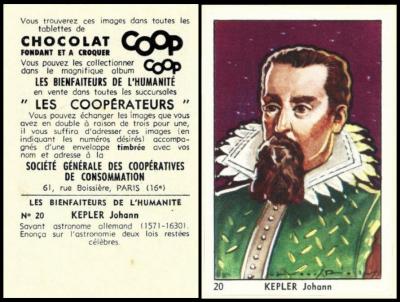
Do note that our set today also contains a card of Kepler (number 20), showing here. This describes him as a "Savant astronome allemand (1571-1630)" - and that means an exceptional German astronomer.
The only thing I have not been able to discover is how many cards are in this set - so the number quoted in the heading is based on the highest number I was able to find on any site online. If you have a higher number, then please let us know so we can adjust this section.
Thursday, 26th December 2024
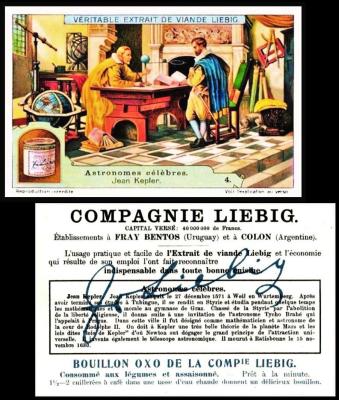
This appears to be the only card which shows Tycho Brahe and Johannes Kepler together, and it seems absent from checklists of either man. This could well be because Tycho Brahe is not named, and Johannes Kepler is shows as Jean.
The two are almost certainly in Prague and apparently in the Observatory, for there is a telescope to the top left hand corner, along with a collection of measuring tools in the top right hand corner. The telescope was a relatively new tool - not only first used by Galileo Galilei, but constructed to his own design. Before that, astronomers used astrolabes, and armillary spheres, one of which is directly pointed at by the end of the telescope in this picture.
I have not been able to find this picture, so it seems that it was drawn to order for Liebig. There is something rather curious about it though, as it seems that Johannes Kepler, in his long vestment, of typically Lutheran form, is leaning on the table like he owns it, and Tycho Brahe is standing, reading, but looking rather ill at ease, and though there is a chair right beside him, it is noticeable that he has not sat down.
This set was only issued in three countries, Belgium (our version, as "Astronomes Celebres"), Germany (as "Aus dem Leben berühmter Astronomen"), and Italy (as "Astronomi celebri"). The German set seems to be the most sought after, and, curiously, the title actually translates to "[scenes] from the life of renowned astronomers", and is a much better description than the other two, because all the cards do indeed show important events, rather than portraits. .
These other cards are :
- Aristote
- Claude Ptolemee
- Gérard Kremer, dit Mercator
- Jean Kepler
- Galilee
- Schiaparelli
Friday, 27th December 2024
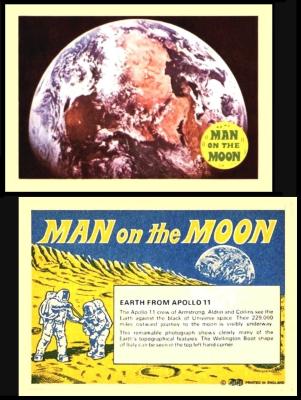
And now we come to the most fascinating facet of Johannes Kepler`s life, for he holds the honour of being the first ever science-fiction writer, with a book called, colloquially, "Somnium", which is Latin for `The Dream`.
In fact its full title is "Somnium, seu opus posthum de astronomia lunari" and it was written in 1608. However Johannes Kepler never got to see it published, and some think that he would not have wanted it to be, but his son, Ludwig, found the manuscript, and showed it to Jacobus Bartsch, who was the husband of Johannes Kepler`s daughter Suzanna, three years younger than Ludwig, and the third Kepler child to be born (as well as the first to survive infancy). Together, they edited it, and it was published in 1634, four years after Johannes Kepler`s death.
It is an odd tale, and, in many parts, a wistful regrettance of the way that Johannes Kepler would have liked his life to work out. It starts with Kepler himself reading a magical book, about a magician, and falling asleep. He dreams of a young boy, from Iceland, who has a mother so intelligent that people think she must be a witch.
This is a very curious thing to write, as his mother was indeed persecuted for being a witch, accused of poisoning another woman with a drink, whilst Johannes Kepler was at the University of Tubingen. She was arrested, and taken to court, and then imprisoned for over a year. However in 1621 she was released and acquitted. After that we do not know what happened, but it is thought she died, though no records exist. Worse than this though, was the fact that one of his mother`s cousins was actually convicted as a witch, and burned to death in his home town.
Anyway the mother in the book takes her son out in the open air and shows him the night skies, (as his own mother had done), and one night she tells him of a magical island called Levania, which she only knew of because a demon had appeared before her and told her. The way she describes it, we instantly know it as the moon, but she also tells of how, when you are on this island, you can see the Earth rising and falling from view.
The mother seems to support herself by selling many things, including potions and herbs. The father is not mentioned. One day the boy ruins a bag filled with these herbs, and his mother sells him to a seaman. They travel the seas for quite some while, though the boy is frequently affected by the motion of the boat, then one day the seaman has to take a letter to an island, on which lives a strange man. This turns out to be Tycho Brahe, and it is by far the most poignant piece of the work, for the boy speaks lovingly of how he is treated kindly on the island, and, because he has a gift for astronomy, the older man spends much time encouraging him into better and better discoveries, and at night they sit up and watch the stars and the planets for hours on end, developing of a very great friendship, and, almost, perhaps, a father-son relationship, something that Johannes Kepler never had, for his father left home when the young boy was only five, and is believed to have died fighting in the Netherlands, though there is no proof of that.
The boy is there with Tycho Brahe for many years, but then, suddenly, he finds out he must leave, and you can feel the regret in those words, much as Johannes Kepler must have felt when he also had to leave.
The next piece brings the boy back to Iceland, where his mother is still alive. He shares with her many of the things that Tycho Brahe has told him and she tells him tales that the demons told her, things that few human people knew. She also reveals that she can travel in time, and cover huge distances in moments, and that there was a way to get to the Island of Levania, though humans have to be sedated, in order to survive the journey, the lack of air, and the cold in between - this being the first depiction of the hazards of space travel. The book then goes into much detail of scientific facts about the moon and the planets, which were later found by astronomers to be true, as well as a few things that were almost certainly added for effect to make a better story. We know that in its original form, written whilst Johannes Kepler was a student, it was far more factual, and that he added the dream sequences, along with the idyllic time with Tycho Brahe, a while later. We just do not know why.
And then, very suddenly, the Kepler in the book wakes up. Some believe that there was more to the book when it was a manuscript, but, for whatever reason, his son chose not to add that, or maybe to destroy it, and to tack on the very abrupt end instead.
To our card, and I am delighted to fill another gap, for we used the sectional part of this set as our Card of the Day on the 27th of August 2023 and so now we can add the version with the "two astronauts". That page remains the home page though, and it also tells of the other versions, by Topps in America and O-Pee-Chee in Canada.
Our original British Trade Index part three (RB.31, published in 1986) lists the two as :
Man On The Moon. 89 x 63. Unnd, (74) ... ABF-59.
Two sections, issued 1969.
1. First section. Scene on back with picture of two astronauts. 1-19 - and then there is a list of titles
2. Second section. Sectional picture on back with picture of spaceship. 20-74 - with another list
In our updated British Trade Index this set is also there, because it was just issued before the cut off date of that volume, which is 1970. However it is a very small description, and it reads
MAN ON THE MOON. 1969. 89 x 63. Unnd (74). Two sections. See HA-27. ... AAB-510
Now the only thing that did fail to get done (because I waxed too lyrical about Somnium), was the card codes for the Diary Dates, but I will add them tomorrow. And I am fairly sure that if I had stopped to do those, then the newsletter would not have been finished.
Now some time over the next week the new calendar of club meeting dates will be uploaded, so watch the revolving banner on the home page. There are some clubs yet to come, so if you have not sent yours along yet please do. In the early days of Spring it is the perfect time for a little drive in the country, and collectors would like to have as many options of where to end up as they can.
Anyway time, and my eyes, are running out. I must retire. Nipper has been asleep for ages.
May I wish you all a Happy New Year, full of adventure, and fun. I know I hope that for myself, for without those things, life can be very dull. And I hope to find as much as I can in the forthcoming months.....
